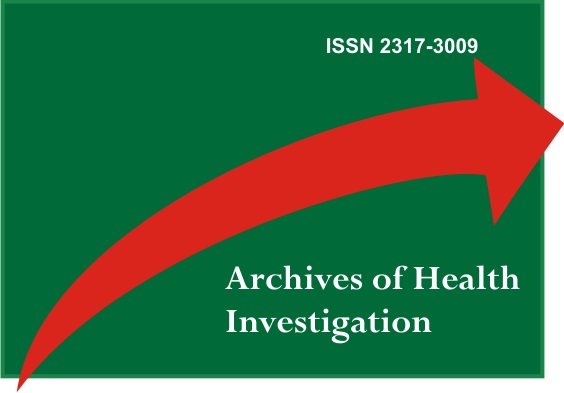Dental-Alveolar Traumatism: Injury to Sustainable Tissue (Luxations)
DOI:
https://doi.org/10.21270/archi.v11i1.5376Keywords:
Dislocations, Tooth Injuries, Diagnosis, TherapeuticsAbstract
Introduction: Lesions to the dental support tissues (dislocations) comprise a group of diverse lesions where the tooth is detached from its original position after a traumatic accident. These injuries are subclassified into: concussion, subluxation, extrusive dislocation, lateral dislocation, intrusion and avulsion. Objective: To carry out a literature review about injuries to dental support tissues (dislocations) addressing etiological aspects, clinical characteristics and forms of treatment for each type of injury. Methods: A bibliographic search was performed in the PubMed / Medline, Scielo and Google academic databases, using publications from the last 10 years as a filter. The search was carried out with previously selected descriptors. The research took place in 3 phases and the articles were included according to the inclusion and exclusion criteria. Results: Dislocations represent a subgroup of the classification of dento-alveolar injuries that affect the tissues that support the teeth. In general, the following tissues are affected after a dislocation injury: periodontal ligament around the tooth, alveolar bone cavity and the tooth's vascular and nervous system. They can range from a simple injury to the periodontal tissues (concussion) to the complete crushing of the fibers of the periodontal ligament and the vasculonervous bundle (intrusion). Conclusion: These injuries usually require special attention, especially with regard to periodontal and pulp tissues, considering that several complications after a traumatic accident may occur. Therefore, it is important that the professional makes an adequate diagnosis for the treatment to be effective.
Downloads
References
Belmonte FM, Day P, Macedo CR, Saconato H, Trevisani VFM. Interventions for treating traumatised permanent front teeth: luxated (dislodged) teeth. Cochrane Database Syst Rev. 2013;(4):CD006203.
Chafaie A. Partial and total luxations of permanent teeth in children: Clinical management. Int Orthod. 2016;14(1):32-47.
Miloro M, Ghali GE, Larsen PE, Waite PD. Princípios de cirurgia bucomaxilofacial de Peterson. 3.ed. São Paulo: Santos; 2016.
Pogrel MA, Kahnberg KE, Anderson L. Cirurgia bucomaxilofacial. Rio de Janeiro: Santos; 2016.
Diangelis AJ, Andreasen JO, Ebeleseder KA, Kenny DJ, Trope M, Sigurdsson A. et al. International Association of Dental Traumatology guidelines for the management of traumatic dental injuries: 1. Fractures and luxations of permanent teeth. Dent Traumatol. 2012;28(3):2-12.
Hupp JR., Ellis III, Tucker MR. Cirurgia oral e maxilofacial contemporânea. 6. ed. Elsevier: Rio de Janeiro; 2015.
Prado R, Salim M. Cirurgia bucomaxilofacial: diagnóstico e tratamento. 2. ed. Rio de Janeiro: Guanabara Koogan; 2018.
Guedes Pinto AC. Odontopediatria. 9.ed. São Paulo: Santos; 2016.
Fonseca RJ, Walker RV, Barber HD, Powers MP, Frost DE. Trauma Bucomaxilofacial. 4. ed. Rio de Janeiro: Elsevier; 2015.
Braga RA, Braga WDF, Girelli CFM, Lacerda MFL, Coelho RG, Junqueira RB. Intrusive Dislocation in Permanent Teeth: Review of Literature and Clinical Case Report. Int J Odontostomat. 2019;13(1):89-92.
Gupta M. Intrusive luxation in primary teeth – Review of literature and report of a case. Saudi Dent J. 2011;23(4):167-76.
Rai P, Pandey RK, Khanna RA. Multidisciplinary approach to the management of traumatic intrusion in immature permanent teeth. BMJ Case Rep. 2016;19.
Costa LA, RIbeiro CCC, Cantanhede LM, Santiago Junior JF, Mendonça MR, Pereira ALP. Treatments for intrusive luxation in permanent teeth: a systematic review and meta-analysis. Int J Oral Maxillofac Surg. 2017;46(2):214-29.
Sarkar PA, Shigli A. Management of traumatic intrusive luxation of incisors in a patient with Down’s syndrome. BMJ Case Rep. 2011;1020114887.
Srivastava A, Gupta N, Marleau A, Afrashtehfar KI. How do I manage a patiente with intrusion of a permanente incisor? J Can Dent Assoc. 2014;80:e50.
Adnan S, Lone MM, Khan FR, Hussain SM, Nagi SE. Which is the most recommended medium for the storage and transport of avulsed teeth? A systematic review. Dent Traumatol. 2018;34(2):59-70.
Poi WR, Sonoda CK, Martins CM, Melo ME, Pellizzer EP, Mendonça MR. et al. Storage Media For Avulsed Teeth: A Literature Review. Braz Dent J. 2013;24(5):473-85.
Andersson L, Andreasen JO, Day P, Heithersay G, Trope M, Diangelis AJ et al. International Association of Dental Traumatology guidelines for the management of traumatic dental injuries: 2. Avulsion of permanente teeth. Dent Traumatol. 2012;28(3):88-96.
Munavalli NA, Sachhi RJ, Kambale SS, Bandekar SD. Maintaining vitality of immediately reimplanted avulsed tooth: Two-year follow-up case report. J. Indian Soc. Pedod. Prev. Dent. 2013;31(2):113-17.
Tuna EB, Yaman D, Yamamato S. What is the Best Root Surface Treatment for Avulsed Teeth? Open Dent J. 2014;8:175-79.
Karayilmaz H, Kirzioglu Z, Gungor OE. Aetiology, treatment patterns and long-term outcomes of tooth avulsion in children and adolescents. Pak J Med Sci, Saddar. 2013;29(2):464-68.
Brullmann D, Schulze RK, D’hoedt B. The treatment of anterior dental trauma. Dtsch Arztebl Int. 2011;108(34-35):565-70.
Steiner DR. Avulsed maxillary central incisors: The case for replantation. Am J Orthod Dentofacial Orthop. 2012;142(1):8-16.
Soares AJ, Prado M, Lima TFR, Gomes BPFA, Zaia AA, Souza-Filho FJ. The Multidisciplinary Management of Avulsed Teeth: A Case Report. Iran Endod J. 2012;7(4):203-6.


